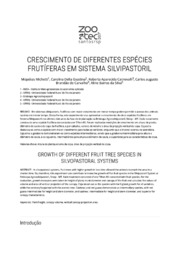Crescimento de diferentes espécies frutíferas em sistema silvipastoril.
Crescimento de diferentes espécies frutíferas em sistema silvipastoril.
Author(s): MICHETTI, M.; GIUSTINA, C. D.; MONTEIRO, R. A. C.; CARVALHO, C. A. B. de; SILVA, A. B. da
Summary: PT-BR: Em sistemas silvipastoris, frutíferas com maior crescimento em menor tempo podem permitir o acesso dos animaisna área em menor tempo. Desta forma, este experimento visa apresentar o crescimento de cinco espécies frutíferas emSistema Silvipastoril nos últimos dois anos da fase de implantação na Embrapa Agrossilvipastoril, Sinop - MT. Cada tratamentoconstou de uma espécie frutífera consorciada com Tifton-85. Foram realizadas medições de crescimento em altura de planta,diâmetro de caule e de copa da frutífera, e por cálculos, valores de volume e área de projeção vertical da copa. Cajazeiradestacou-se como a espécie com maior crescimento para todas as variáveis, enquanto que o inverso ocorreu na aceroleira.Cajueiros e goiabeira demonstraram-se como espécies intermediárias, sendo que a goiabeira intermediária para altura ediâmetro de caule, e os cajueiros, intermediários para altura e diâmetro de caule, e superiores para as características de copa. | EN: ln silvopastoral systems, fruit trees with higher growth in less time allowed the animais to reach the area in ashorter time. So, therefore, this experiment can contribute to know the growth of five fruit species in the Silvipastoril System atEmbrapa Agrossilvipastoril, Sinop - MT. Each treatment consisted of one Tifton-85 consorted with fruit species. For theevaluation, growth measures were taken in height of plant, trunk diameter and canopy ofthe fruit and calculate the values ofvolume and area of vertical projection of the canopy. Caja stood out as the species with the highest growth for all variables,while the contrary happened with the acerola tree. Cashews and red guava demonstrate as intermediary species, with redguava intermediate for height and stem dia meter, and cashew, intermediate for height and stem diameter, and superior forcanopy characteristics.
Publication year: 2017
Types of publication: Paper in annals and proceedings
Observation
Some of Embrapa's publications are published as ePub files. To read them, use or download one of the following free software options to your computer or mobile device. Android: Google Play Books; IOS: iBooks; Windows and Linux: Calibre.
Access other publications
Access the Agricultural Research Database (BDPA) to consult Embrapa's full library collection and records.
Visit Embrapa Bookstore to purchase books and other publications sold by Embrapa.

